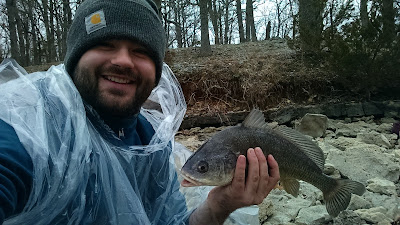Investigating Drum: Dossier
 |
| An average size drum I caught at Lake of the Ozarks last year. All in all, I caught nearly thirty in two days. |
 |
| Notice the commonalities in habitat that this area shares with the above photo. |
Let's begin...
Habitat: In my experience, drum like three major habitats. Rocks, sand/mud, and deep water.
Lakes and Reservoirs
 |
| What I caught my most recent drum on |
Key Baits: Worms and minnow imitations. This could be crank baits or rooster tails. Experiment!
Time of Day: Drum, like any fish, are more active in the morning and evening, however, they are often the only fish that will chomp your bait when there are bluebird skies.
Second, sandy, silty areas. I've caught more drum in river habitats this way. In a reservoir, you can try nightcrawlers and cut bait in old river channels. Sand humps, I've been told, also hold them. Again, crank baits work. It's the chagrin of a bass fisherman to pull up a monster drum while fishing a tournament.
Third, deep water structure. I don't have a boat, but in the colder months, I've heard that they congregate in main lake areas that are impossible to get to without some sort of aquatic transportation. I've seen videos of people jigging for them on the great lakes. It's on my bucket list.
Streams and Rivers
Most streams and rivers hold drum. Focus downstream of riffles, which are areas of shallow water that lead to deep holes. Drum will mosey up to these spots and cruise the bottom to suck up crayfish, worms, and baitfish that come downstream.
One of my favorite fishing memories was catching drum in an ozark mountain stream on light tackle. They battles were epic and all I was using was a small circle hook with a worm on the end. One of my catches was under the seemingly endless, starlight heavens. It doesn't get better than that.
You can also catch them on muddy runs in rivers, particularly after rain. Be prepared to catch some carp as well.
So, is it good fried?
Um, well, not really. It isn't bad, but it's pretty low on my list of fish fry candidates. Drum is very oily, like salmon, and so it just doesn't lend itself to the flavor and texture we expect of a white fish. It's better to think of them in the way we think of redfish or black drum. Go for blackened or pan seared. I have a few more recipes to try, including using them for fish cakes. It's all about preparation.
 |
| It looked so promising... |
Aren't they boney?
Nope. They have a different bone structure than bass, but they don't have weird y bones like a carp. They are, granted, a relatively low yielding fish for their size (big fish with not so much meat), but they aren't difficult to fillet. They have large pin bones at the top of the ribs that you cut over, as if they were a second pair of ribs. Many ocean fish have a similar skeletal pattern. Even a beginner can get a boneless fillet from a drum.


Comments
Post a Comment